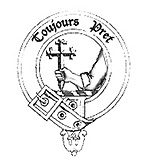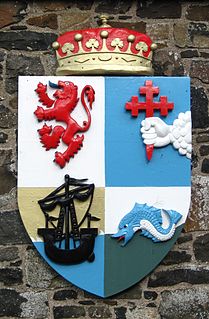| |||||
| Centuries: | |||||
|---|---|---|---|---|---|
| Decades: | |||||
| See also: | Other events of 1565 List of years in Ireland | ||||
Events from the year 1565 in Ireland.
| |||||
| Centuries: | |||||
|---|---|---|---|---|---|
| Decades: | |||||
| See also: | Other events of 1565 List of years in Ireland | ||||
Events from the year 1565 in Ireland.
Sorley Boy MacDonnell, also spelt as MacDonald, Scoto-Irish chief, was the son of Alexander MacDonnell, lord of Islay and Kintyre (Cantire), and Catherine, daughter of the Lord of Ardnamurchan, both in Scotland. MacDonnell is best known for establishing the MacDonnell clan in Antrim, Ireland, and resisting the campaign of Shane O'Neill and the English crown to expel the clan from Ireland. Sorley Boy's connection to other Irish Catholic lords was complicated, but also culturally and familiarly strong: for example, he married Mary O'Neill the daughter of Conn O'Neill. He is also known in English as Somerled and Somerled of the yellow hair.

Sir Henry Sidney, Lord Deputy of Ireland, was the eldest son of Sir William Sidney of Penshurst, a prominent politician and courtier during the reigns of Henry VIII and Edward VI, from both of whom he received extensive grants of land, including the manor of Penshurst in Kent, which became the principal residence of the family.

Shane O'Neill, was an Irish chieftain of the O'Neill dynasty of Ulster in the mid-16th century. Shane O'Neill's career was marked by his ambition to be the O'Neill—sovereign of the dominant O'Neill family of Tír Eoghain—and thus overlord of the entire province. This brought him into conflict with competing branches of the O'Neill family and with the English government in Ireland, who recognised a rival claim. Shane's support was considered worth gaining by the English even during the lifetime of his father Conn O'Neill, 1st Earl of Tyrone. But rejecting overtures from Thomas Radclyffe, 3rd Earl of Sussex, the lord deputy from 1556, Shane refused to help the English against the Scottish settlers on the coast of Antrim, allying himself for a short time instead with the MacDonnells, the most powerful of these settlers, Shane viewed the Scottish settlers as invaders, but decided to stay his hand against them with hopes of using them to strengthen his position with the English; however, tensions quickly boiled over and he declared war on the Scottish MacDonnell's defeating them at the Battle of Glentaisie despite the MacDonnells calling for reinforcements from Scotland. The Scottish MacDonnells would later assassinate Shane O'Neill and collect the bounty on his head.

Gerald FitzGerald, 14th Earl of Desmond, also counted as the 15th or 16th, owned large part of the Irish province of Munster. In 1565 he fought the private Battle of Affane against his neighbours, the Butlers. After this he was for some time a prisoner in the Tower of London. The First Desmond Rebellion took place during his absence. He was the leader of the Second Desmond Rebellion from 1579 to his death and was therefore called the Rebel Earl. He was attainted in 1582 and went into hiding but was hunted down and killed.
James FitzMaurice was a member of the 16th century ruling Geraldine dynasty in the province of Munster in Ireland. He rebelled against the crown authority of Queen Elizabeth I of England in response to the onset of the Tudor conquest of Ireland. He led the first of the Desmond Rebellions in 1569, spent a period in exile in continental Europe, but returned with an invasion force in 1579. He died shortly after landing.

The Battle of Affane was fought in county Waterford, in south-eastern Ireland, in 1565, between the forces of the Fitzgerald Earl of Desmond and the Butler Earl of Ormond. The battle ended in the rout of the Desmond forces. It was one of the last private battles fought in Britain or Ireland.
The Battle of Farsetmore was fought near Letterkenny in County Donegal, north-western Ireland, on 8 May 1567, between the O'Neill and O'Donnell Túath. Shane O'Neill, chief of the O'Neills of Tír Eoghain, was defeated by Aodh mac Maghnusa Ó Domhnaill and the O'Donnells freed themselves from O'Neill aspirations of ruling Ulster as its King.
The Battle of Glentaisie, was a battle between the native Ulster Irish and Scottish settlers the MacDonnell's fought in the north of Ulster on 2 May 1565. The result was a victory for Shane O'Neill over the Clan MacDonald of Dunnyveg. The conflict was a part of the political and military struggle, involving the English and occasionally the Scots, for control of northern Ireland. Although the MacDonalds were a Scottish family, based principally on the island of Islay in the Hebrides, they had long been associated with the Gaelic polity rather than the Kingdom of Scotland.

Clan MacDonald of Dunnyveg, also known as Clan Donald South, Clan Iain Mor, Clan MacDonald of Islay and Kintyre, MacDonalds of the Glens (Antrim) and sometimes referred to as MacDonnells, is a Scottish clan and a branch of Clan Donald. The founder of the MacDonalds of Dunnyveg is Eòin Mòr Tànaiste Mac Dhòmhnaill, a son of Iain Mic Dhòmhnaill and Margaret Stewart of Scotland, daughter of King Robert II. Members of the clan actually pronounced and spelled their name M'Connall due to the Gaelic pronunciation of the name Mac Domhnuill thus giving rise to the surname McConnell and its variants. While historically recognised as a clan by the Court of the Lord Lyon, it is now an armigerous clan as it no longer has a chief. The last chief was Sir James MacDonald, 9th of the Clan MacDonald of Dunnyveg or Clan Donald South, who died in London in 1626.

The MacDonnells of Antrim, also known as the MacDonnells of the Glens, are a branch in Ireland of the primarily Scottish-based Clan Donald. Initially part of Clan MacDonald of Dunnyveg, the MacDonnells of Antrim became their own branch in 1558 when Somhairle Buidhe MacDonnell obtained the lordship of the territory in Ireland from James MacDonald, 6th chief of the Clan MacDonald of Dunnyveg. The MacDonnells of Antrim were a sept of the powerful Clan Donald of the royal Clann Somhairle,, that the English crown had attempted to cultivate since the early 14th century in its efforts to influence the course of politics in Scotland. The MacDonnells established a growing presence in Ireland throughout the 15th and 16th centuries, and played a crucial role in the politics of 17th century Ireland. The MacDonnell's achieved much success in Ireland largely to cultural and familial connections to the Gaelic nobility of Ireland. Today the surname is predominantly spelled McDonnell in Ireland and abroad, although many McConnells are also of the same family, as are the McDaniels. Many of the present day McDonnells have a common descent from Sorley Boy MacDonnell.
Events from the year 1558 in Ireland.

Dunaneeny Castle is a ruined castle on the outskirts of Ballycastle in County Antrim, Northern Ireland. The castle was home to the chiefs of Clan MacDonald of Dunnyveg and later the MacDonnells of Antrim. The castle is purported to be the birthplace of Scottish-Irish chief Sorley Boy MacDonnell.
Connor O'Brien, 3rd Earl of Thomond, called Groibleach, grandson of Conor O'Brien ; succeeded to the earldom, 1553; his right to the lordship of Thomond was disputed by his uncle, Donnell; confirmed in his possessions by Thomas Radclyffe, 3rd Earl of Sussex in 1558, who proclaimed his uncles traitors, though peace was not established until 1565. He intrigued with Fitzgerald in 1569, and fled to France; returned to Ireland and received pardon, 1571, with the restoration of his lands, 1573.
Glentaisie is one of the nine Glens of Antrim in County Antrim, Northern Ireland. It was shaped during the Ice Age by glaciers. The glen is most northerly of the nine glens and lies at the foot of Knocklayde mountain. The town of Ballycastle lies on the coast at the foot of the glen.

Red Bay Castle is situated in County Antrim, Northern Ireland, on a headland projecting into the sea north of Glenariff situated on the road to Cushendall.
Séamus Mac Dhòmhnaill aka James MacDonald, alias McDonnell, 6th Laird of Dunnyveg, Scottish-Irish lord, died 1565.
Alexander Carragh MacDonnell, also spelt MacDonald, was the 5th lord of Dunnyveg, Scotland, alive c. 1480–1538.

The history of the Bissett family in Ireland can be studied independently from that of the originally identical family in Scotland, because of their unique experience following their arrival in Ulster in the early or mid-13th century. Here, while still remaining involved in Scottish affairs, the Bissetts would establish themselves as the Lords of the Glens of Antrim and quickly become equally, then eventually more involved in the politics of the Irish province, becoming among the most Gaelicised of all the so-called Anglo-Norman families in Ireland. The heads of the leading branch of the family soon adopted the Gaelic lineage style Mac Eoin Bissett, by which they are known in the Irish annals, and which translates as "Son/Descendant of John Byset", after a prominent ancestor born in Scotland. In a number of English and Anglo-Norman sources the same head of the family is referred to as the Baron Bissett, also with variants.
Ballycastle Castle was a castle located at Ballycastle in County Antrim in Northern Ireland.